The post Women working with wood appeared first on .
]]>When Patt Gregory decided to train as a carpenter, she was the only woman on the course – and later the only woman working on a building site. Her skill didn’t come naturally, she says, but she persisted and her persistence paid off because these days the Mullumbimby wood wizard has found her calling – encouraging and teaching women of all ages to become indepdendent woodwise…
My aim is to help the student become independent at home, and many walk away excited to clear a space for themselves in the garage, knock up a workbench and scour hubby’s tool box for useful tools they’ve learnt to use! Birthday and Christmas gifts change from toasters to tools!
When some women hear that I teach woodwork, they often say, “I’ve always wanted to do woodwork but I just don’t know where to start”. It does seem like a huge hurdle to most people, but like anything else if we chunk it down into small enough pieces or steps, it becomes much clearer.
You don’t need a speck of experience to learn woodwork, just a willingness to give it a go, a few tools that wont break the budget and the decision to measure and mark carefully and, to follow each step to the letter (no skipping bits!) If you cook cakes you will know that if you get the proportions of the sugar and butter right and beat it together properly, and set the oven temp just so, then the cake wont sink in the middle. If you measure and mark accurately you will have the best chance of building an attractive, impressive and strong project.
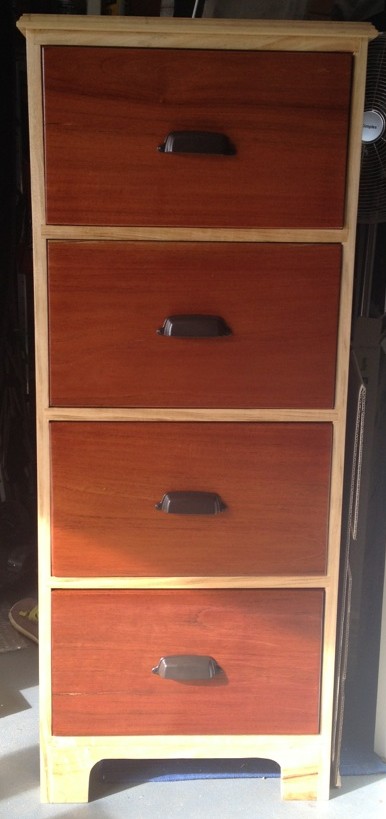
Mel Bautista of Byron Bay made this camphor laurel and red cedar set of drawers using traditional joinery
including dovetails, as a gift for her husband.
I STRUGGLED
I jumped into a new adventure with wood 30 years ago when I saw a one line ad in the Bristol Evening Post while I was living in the UK, which read ‘Woodwork for Women course’. I have to tell you, I was transformed by the experience. Having done all types of ordinary jobs since leaving school, I was keen to get into something practical using my own hands to create something, and not have to ask someone else for help.
Much to the amusement of my friends (I have a petite build!) I decided to train as a Carpenter/Joiner and along with 26 lads we enrolled in a Bristol Training Centre where I learnt everything from roofing (4 inch nails and hammers in those days – no nail guns!) to stair-casing to making dovetails, to building a glass-paneled door.
I DIDN’T GET IT
I loved every day of the course, but I struggled. I didn’t seem to ‘get it’ like the boys did. After all, I wasn’t allowed in the shed with my dad building as a kid, I had to help mum in the kitchen bottling the blackberry jam!
Sid, my teacher would show me the techniques and leave it to me to figure out. I felt clumsy handling the tools, my maths let me down and I would shed a few tears when no-one was looking. I didn’t know what questions to ask. I made every mistake there was to make! But I loved the wood, and the ‘whooshing’ sound of the plane as it licked off yellow curls of pinewood, so I just kept going with it.
I graduated and went toolkit in hand to get a job on a building site. Later I was asked to train as a woodwork teacher in a Women’s Centre, to help women get back into the workforce and learn woodwork as a trade. It was here I realized that teaching woodwork was my calling and that I could fill in all those gaps of information for the students that I didn’t get when I was learning and see what a huge difference it made.
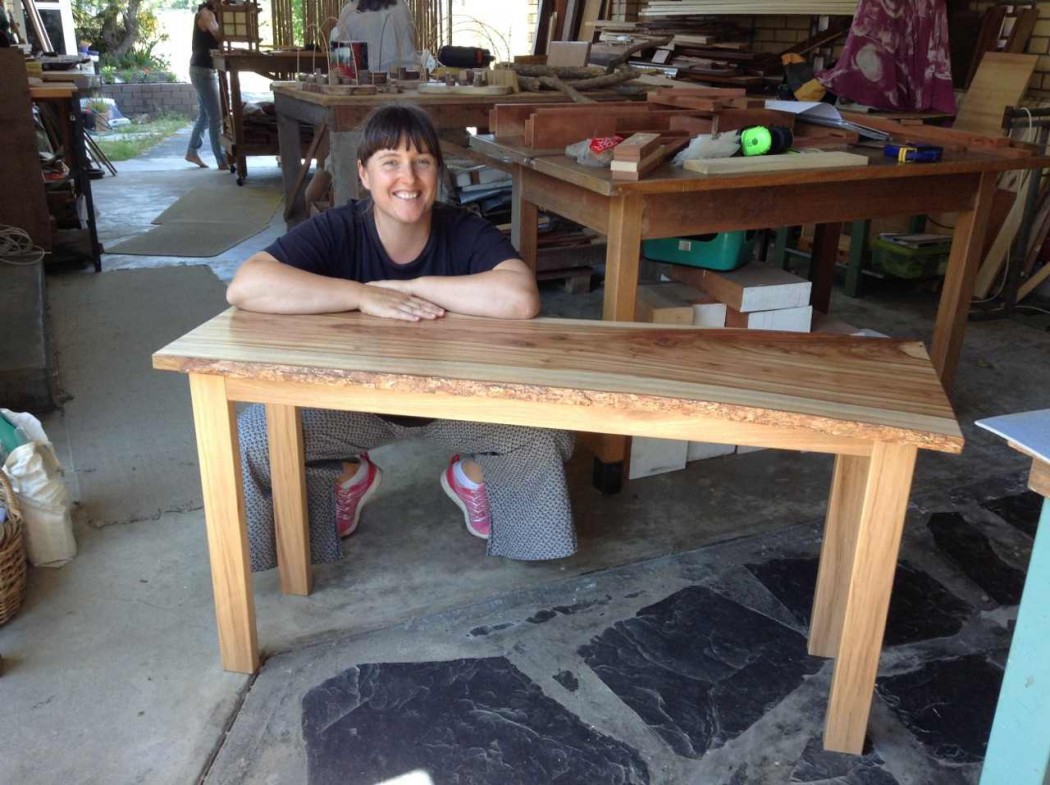
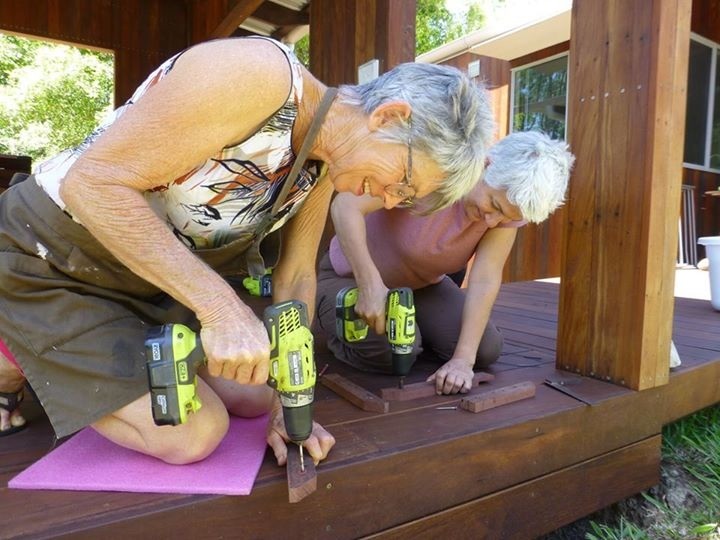
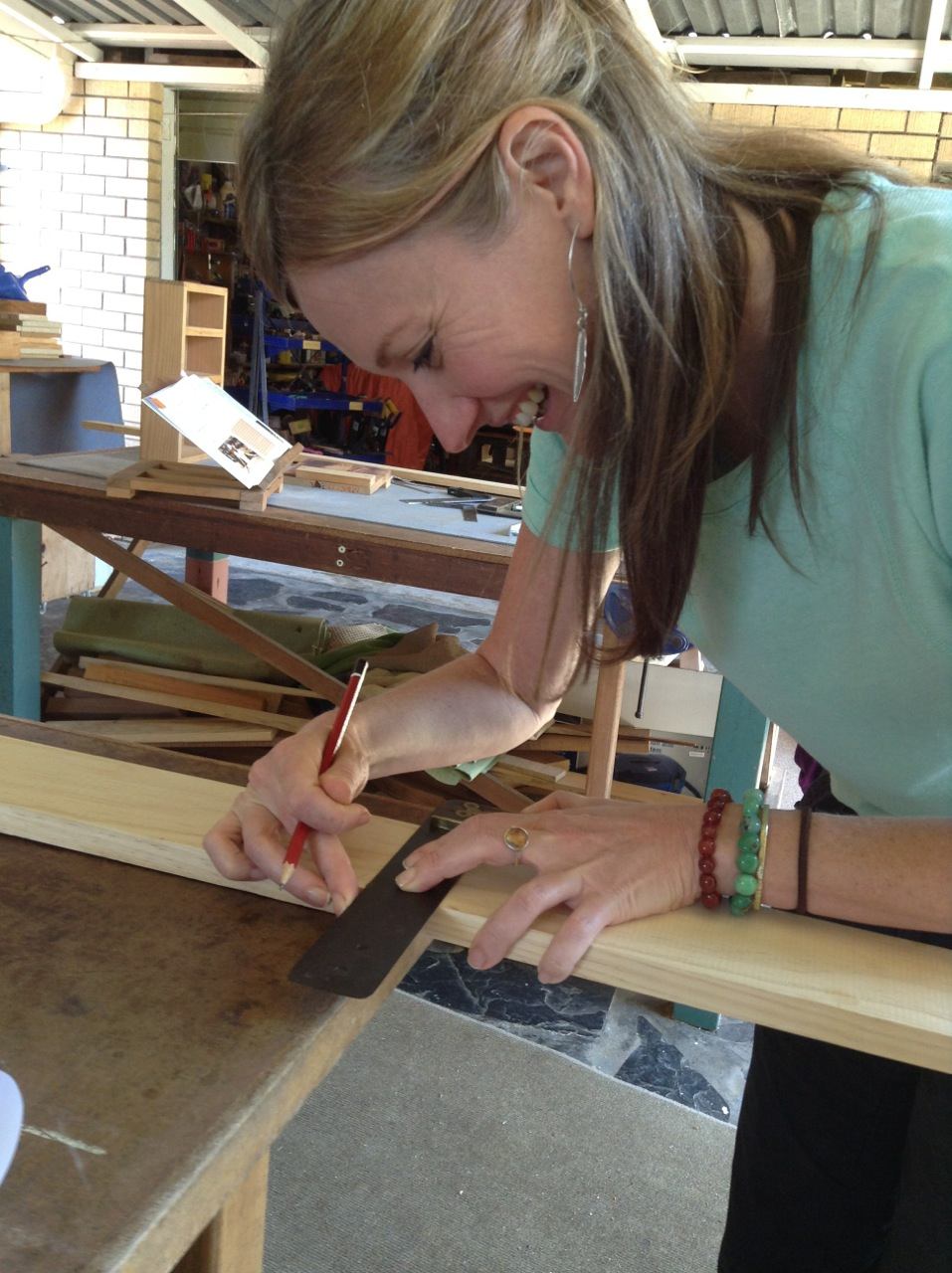
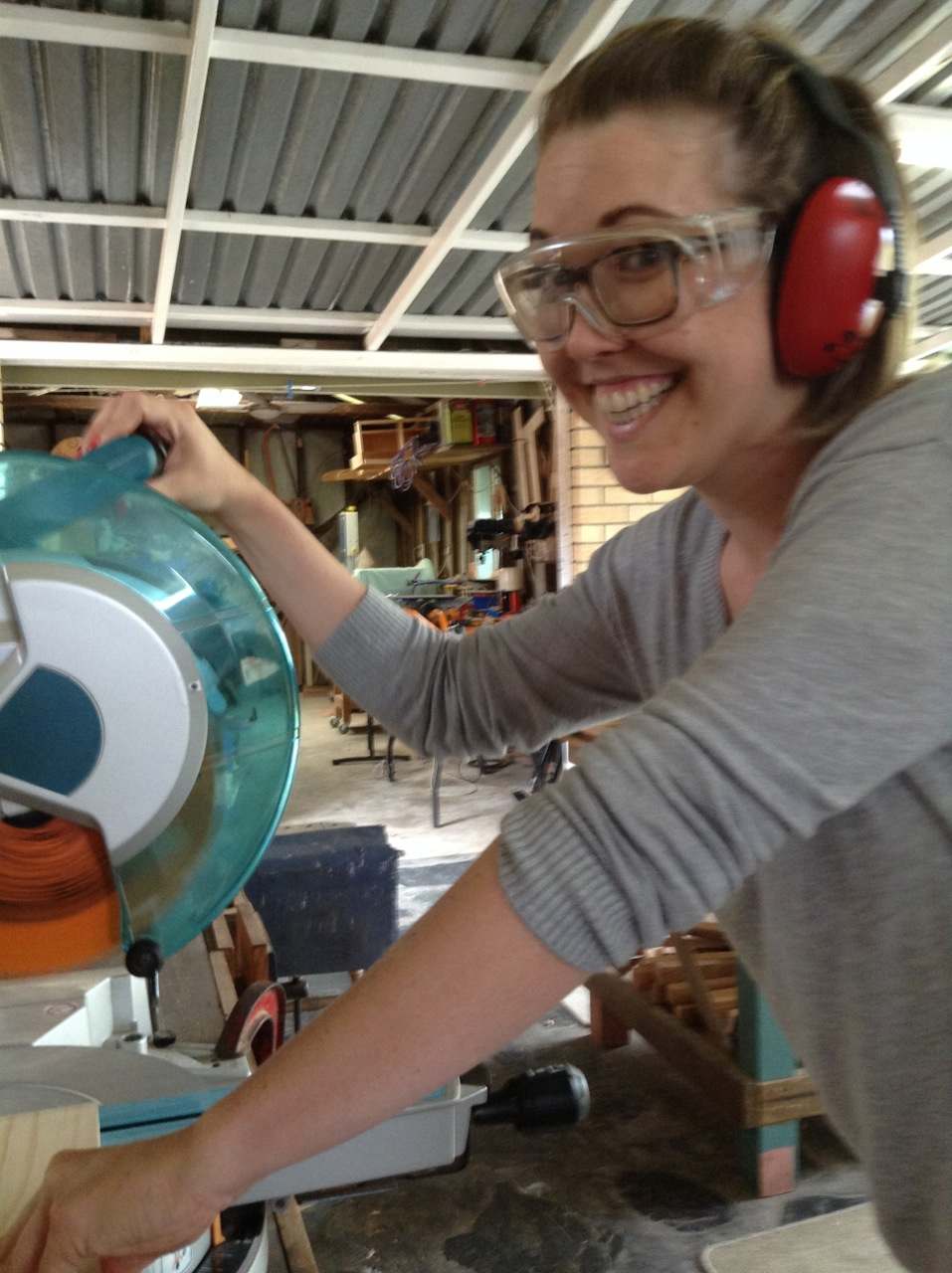

Clockwise from top left: Sophie Heard did a WW4W course, and has started her own woodwork business (Woodwork by Sophie); Maggie Golightly has built her own house and is seen here passing on her skills to Sono; Madonna measures up; Carryn with the power tools, and Kelly with her custom-made herb hanger.
THE SECRET OF THOSE SECRETS
Woodwork seems to, those outside, as if it holds hidden knowledge, mysterious secrets – and a different language. But when you peel away those mysteries woodwork becomes transparent. It’s mostly just a matter of following small clear steps. Many books and magazines seem to leave out small but vital bits of information, or they just assume knowledge when there’s been no chance to learn it.
Woodworking has been a male domain for eons. Even though it was a woman – Tabitha Babbitt – who invented the circular saw way back in the late 1800’s and even though women (especially during the seventies) have been quietly woodworking away in their sheds and studio, we don’t get to hear much about it.
I‘d like to see us women get out there in the mainstream to help change the perspective that woodworking is a male skill. It doesn’t always come naturally to everyone. However, if a young child gets the opportunity to be with their dad (or mum) in the workshop and is positively encouraged to muck around with hammers and nails and saws, they are more likely to take on a level of knowledge that makes it much easier to grasp it later on.
I know lots of guys who struggle to put two pieces of wood together and it’s harder for them in one way, because it’s expected that they should know. That basic introduction early can make a useful impression on us while we’re growing up.
POWER SAW INITIATION
When women come to the workshop, some are not at all confident about the thought of using the tools and particularly the power tools. My aim is to help change their perspective about the electric saw in particular. I don’t believe it’s useful to teach with fear methods (I watched two hours of bloody, gory video when I was trained – it wasn’t useful!)
I believe it’s important to learn to be present, focused, calm and in control of the machine and not fearful. Aware yes, but not terrified. I introduce this tool in a particular way and judging by the smiles after a few goes, the fears aren’t a barrier any longer.
THE SONG OF THE SAW
It’s understandable to think that hand sawing is sweaty, noisy, dusty, hard work but this is the poem I made up to read to my students just before they learn to use a handsaw:
The Song of the Saw
Have you ever listened to the Song of the Saw?
How it changes its pitch, just before the end of the cut…
You don’t have to be strong…
It’s not like hacking of a branch in the garden…
Sawing is a gentle art.
When learning how to saw straight, body position is of utmost importance. There are five steps to sawing accurately. For example, take care to align your shoulder with the cutting line on the wood. Put your left foot forward and your right foot back (if you are right handed). Sounds like a dance doesn’t it? Well, it is in a way. Body and hand position are important all the way through woodworking techniques, with both hand and power tools.
TIPS AND TRICKS
Knowing little tricks of the trade can make the world of difference between throwing down the hammer in frustration and enjoying the building of your project. Just the tiniest of tips can be useful to the complete beginner. For example – it’s maddening to burr the top of a screw because the tip of the driver keeps skipping around. So, when using screws with an electric or battery drill, be sure to keep the tip of the driver very firmly and consistently in the top of the screw. The secret is to use a medium to slow speed, not high speed. Even when extracting a screw still keep the pressure in the screw head.
LISTEN TO THE SOUND
Swinging a hammer madly is a hit and miss affair as we all know, but knowing how to hold the hammer towards the base of the handle and to swing from the wrist aiming to hit the centre of the nail with the flat part of the hammer head, can make a big difference. The two should come together flat and square and not at an angle or the nail will bend. A tip is to listen to the sound as you strike the nail. Is it a high pitched ring or a dull clunk ? The high pitch will warn you that the hammer-head is hitting off centre and most likely the nail will bend. The dull ‘thunk’ lets you know all is well!
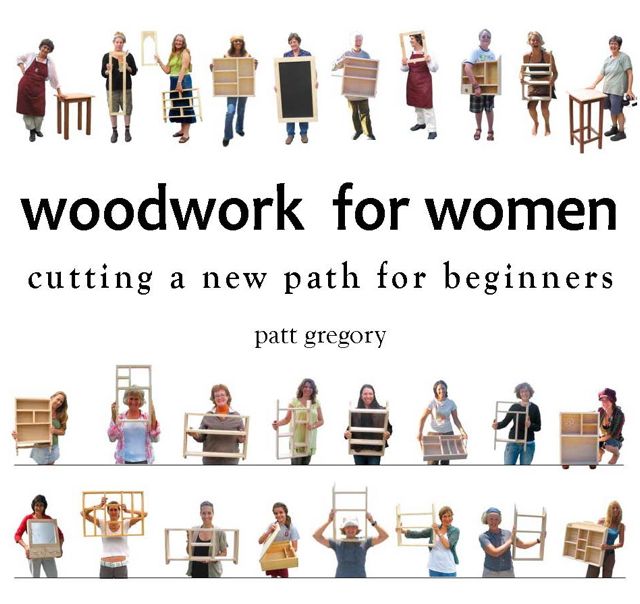
Woodwork for Women – Cutting a New Path for Beginners is available to purchase online at www.woodworkforwomen.com.au $45 including overnight postage or at the Mullumbimby Bookshop and The Timber Slab Factory, Mullumbimby. There is also a 150 min DVD of techniques that correspond to the 20 steps in the book. Pre-launch copy $20
A FEW GOOD TOOLS
To start all you need is a good woodwork manual, (borrow from the library until you discover one you relate to best, then buy it at your local book store or online) a hammer, chisel, wooden mallet, a tenon saw, or japanese saw, drill with bits and drivers, tape measure, steel rule, Try square, soft leaded 2B pencil, sharpener and eraser. And of course you will need a sturdy work surface to work on. At first it could even just be a wooden outdoor table with a sheet of 6mm ply temporarily clamped to the top.
FROM TOASTERS TO TOOLS
When students come to my workshop I love seeing those eager faces, keen to get their hands on some wood and some tools. Even more joy for me at the end of four short days is when they proudly hold their piece up. Some can’t wait to show their woodworking dads and be able to now speak the lingo with them – it can open up a whole new frequency on which to communicate.
Patt Gregory is an author and founder of Woodwork for Women
woodworkforwomen Facebook Woodwork for Women: Phone 0266843160: Mobile 0423722375
The post Women working with wood appeared first on .
]]>